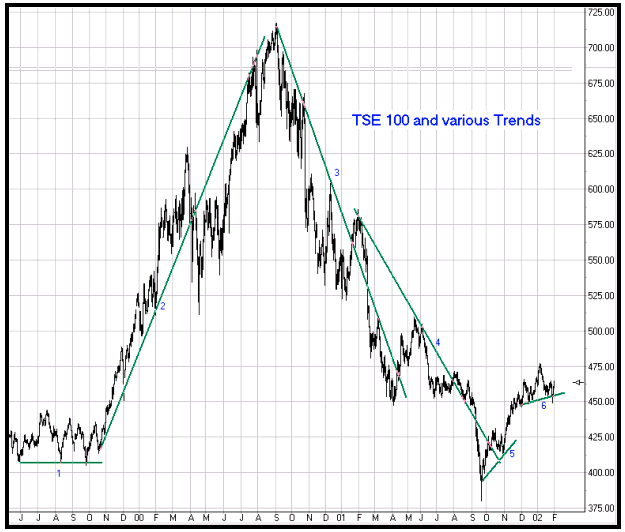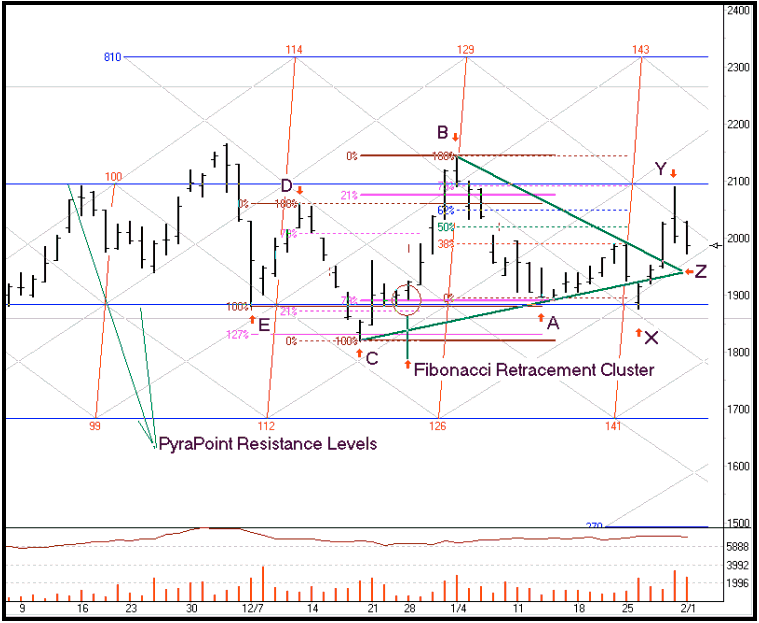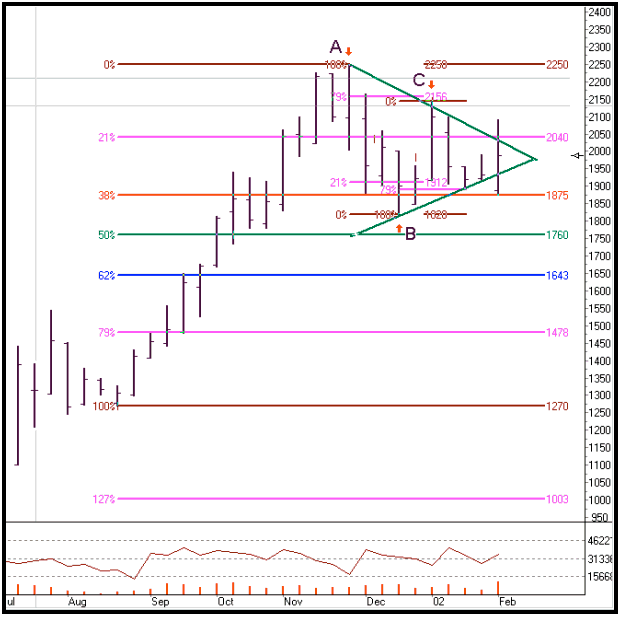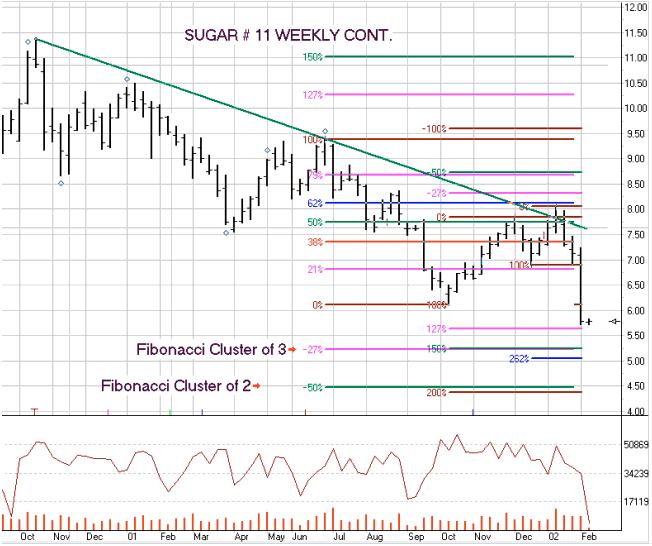February 2002Article:
What is Technical Analysis? Part
III
by James E. Young CMT
(Editor's Note: Mr. Young publishes a weekly
newsletter called the JEY Analytics. This material from
Volume 1 Issue 3 is published by permission. To subscribe to
JEY Analytics call 905-450-6102 or e-mail info@jeyassociates.com
for subscription rates. His web site is http://www.jeyassociates.com/.)
As I promised in the last issue this week I will present two
additional definitions of Technical Analysis and the three basic
premises, (assumptions), on why TA works.
These additional definitions are provided to show that the one
presented in the first issue, while true, just may not be
all-inclusive. These additional definitions cover the thought
from a different point of view. Definition two is by Martin
Pring in his book "Technical Analysis Explained", ‘is to identify
trend changes at an early stage and to maintain an investment
posture until the weight of the evidence indicates that the trend
has reversed’. Martin likens Technical Analysis to an Art,
by this he is placing emphasis on the ability of the chart reader to
identify the trend correctly. He is implying that not all
readers of the same chart will see the same thing.
Our next definition comes from Robert Rotella in his book, ‘The
Elements of Successful Trading’. In his book he breaks his
definition into two parts, (a) Technical analysis is the study of
past market behavior to determine the current state or condition of
the market, and (b) … can be used in both a reactive or
predictive way to analyze the market. The first part is
where market technicians research past data and observe what happens
to the market when various patterns are noted. Then, when a
similar pattern appears he would expect a similar result. Not
much different than what a doctors does, you tell what’s wrong,
symptoms, and he comes up with a diagnose. In the second part
a reactive method is where one responds to a situation. It’s
raining outside, therefore an umbrella would be useful, while a
predictive method is where one tries to anticipate what may
happen. There are very large, dark clouds on the horizon one
would take an umbrella for protection from the rain.
In our future issues we will be showing many examples that
pertain to all three definitions.
The three basic premises of technical analysis are:
The statement, "market action discounts everything", is,
according to John Murphy, probably the corner stone of technical
analysis. A technician believes that anything that could
possibly happen to affect the price of a financial instrument is
already reflected in its price. On a more technical basis a
technician is just studying the actions of supply and demand as a
result of economic demands for goods. If demand exceeds supply
then price will rise whereas if supply outstrips demand price will
retreat. The technician then, is just interpreting what the
chart is saying about the psychology of the market players.
Therefore, it follows then that if everything that affects market
price is ultimately in market price, then the study of market price
is all that is necessary.
The realization that prices move in trends is the key to
technical analysis, per Martin Pring’s definition. It is a
known fact that prices move in three trends, but what escapes most
observers is that prices spend less time in trends, thirty percent,
than in any other mode. There are several very important
quotations that traders and investors should commit to memory or
even place above their computers. The first is an adaptation
of Newton’s first law of motion, ‘A trend in motion is more likely
to continue than to reverse’, or ‘Let the trend be your friend’ this
one is based on the notion that one should follow a trend for a long
as possible.
In the daily close only chart of the TSE-100 in Figure 1 you can
observe several enumerated trend lines. Trends 1, 2, 5, and 6
are acting as support, while trends 3 and 4 are acting as
resistance. The region at Trend1 shows a period of
accumulation while during trend 2 we see a mark-up of price.
Trend 3 therefore shows distribution and a markdown of price due to
an over supply and so it continues with the other trends.

Figure 1 TSE 100 showing various trend
lines.
Chart Courtesy of Ensign
Software
The final premise history repeats itself is actually the study of
human psychology. It is the actions of humans that cause the
chart bars to form the various patterns to form. These
patterns are none other than the reaction of humans driven by fear,
greed, hope, and ego. Some of us may learn from our mistakes
while others will not and they will leave, making room for new
players. These new players will in turn make the same mistakes
until they learn to observe the charts and the messages contained
within.
At the same time there is the concept of the crowd
as written about by Tony Plummer in his book, ‘The Psychology of
Technical Analysis’, ‘Natural forces encourage people to indulge in
group behavior. Groups behave as single organisms: they
therefore respond in a predictable way to information shocks, they
have metabolic (emotional) cycles, and they follow a definable path
of growth and decay. Unlike any other crowd, however, the
behavior of financial market crowds is clearly reflected in simple,
and specific indicators. These are the price movements
themselves…’ This, then, can explain why we see the many
different patterns on the charts.
Commodity of the Week:
The Chart of March Oats is particularly interesting
in that the price decline out of the symmetrical triangle stopped
right on the 38% Fibonacci retracement of the Aug Low at $1.26 to
the Nov High at $2.25. It then bounced of the $1.87 level to
climb 0.215 cents for a value of $1,075 less commission. This
trade is even more spectacular when you add other Fibonacci
retracement levels on the immediate past two trends. Trend A-B
shows us that at 21%, $1.91¼ it is very close to the opening price
$1.88¾ while using trend B-C the 79% retracement level is right on
the opening. Therefore by placing the FR tool on the BC trend
and an alert one tick above we could have been well prepared.
All that would have remained is to make that all-important call.

Chart 1 - March Oats Daily
Chart Courtesy of Ensign
Software
The daily Chart 1 of March Oats contains a Symmetrical Triangle
BZC, PyraPoint tool, several instances of Fibonacci Retracement for
trends A-B, C-B and E-D. These cause a cluster of retracements
to be defined which define a price level with a stronger probability
of acting as support and resistance. The PP tool that is based
on W.D. Gann’s square of nine produces automatic S/R based on
degrees of 360 and diagonal S/R on 45-degree angles. It can be
seen in the above chart that there is very strong support at the
$1.87 from both FR and the PP tool. Close examination will
also show the opening price of the bar at "X" was equal to 79% of
the CB trend and the high of $2.09 was equal to 79% of the BA trend
and the PP tool at "Y".

Chart 2 - Oats Weekly
Chart Courtesy of Ensign
Software
This Weekly Oats continuation chart 2 shows the
relationship of the last weeks low to the 38% Fibonacci retracement
and the false breakout to the downside.
It is the ability to plan trades like this well in
advance that separates the winners from the losers. With
margin at $675.00 you figure out the potential offered in a trade of
this type. Don’t forget to allow for commission and some
slippage for poor fills.

Chart 3 - Sugar #11 Weekly
Chart Courtesy of Ensign
Software
The weekly continuation chart 3 of Sugar #11 has
support at 127% retracement. However there are two clusters
immediately below. The first one is a cluster of three with
262% the lowest at about $5.02. The next set are at $4.40 -
$4.50. Terminating at 262% would agree with the length of a
Wave 3 retracement.
Study Tip:
Protective Stops
Strategy
by Howard Arrington
Initial Stop:
- Upon entering the market Long, place a stop-loss below the low
of the V or W bottom turn.
- Upon entering the market Short, place a stop-loss above the
high of the V or W top turn.
- The stop is placed to avoid exiting a correct position during
a normal retest of the turn.
Stop Adjustment (assuming a Long position):
- On the 5th bar from the turn, move your stop-loss to your
entry price so that your position becomes a 'no-risk' trade.
If the low of the 5th bar is below your entry price, then place
the stop at the low of the 5th bar instead of at your entry price.
- On the 8th bar, raise your stop to the low of the last 5 bars.
- On the 13th bar, raise your stop to the low of the last 4
bars.
- On the 21st bar, raise your stop to the low of the last 3
bars.
- On the 34th bar, raise your stop to the low of the last 2
bars, and adjust with each succeeding bar.
Exiting A Position:
- Using the strategy for the protective stops, the exit will
take care of itself.

The illustration shows theoretical stop adjustments numbered
according to the strategy statements given for the stop
adjustment. X marks the turning point the bar counting is made
from and the initial stop placement. Disclaimer:
This stop strategy has not been sufficiently researched. It
might be worthless.
Hardware Tip:
High Speed Internet
by
Howard Arrington
There are 5 ways to connect to the Internet: dial-up modem, DSL
(Digital Subscriber Line), wireless, cable modem, and
satellite. Not all services are available in all areas of the
country. You will have to check with local Internet Service
Providers (ISP) to determine what is available to you. All of
these services are available in my community of 50,000 in Eastern
Idaho.
For years my Internet access was through dial-up modem for $18
per month with connection speeds around 28 kbps. Last
summer I tried to get a wireless connection because it would be much
faster than dial-up, but discovered that a power line in the line of
site between my office antenna and the radio tower introduced
interference that made wireless unreliable. I then
changed to cable modem ($150 equipment cost) and now use CableOne
for $45 per month with upload speeds of 140 kbps and download speeds
of 400 kbps. I am happy with this. I would never
be satisfied to go back to the s..l..o..w.. dial-up
modem, although I have a dial-up account as a backup.
Your phone company must verify that your phone lines are suitable
for DSL service even if it is available in your community. My
office is 5 miles away from the telephone exchange which is beyond
the current distance limit of 18,000 feet for a DSL phone line in my
community.
If you cannot obtain a high speed wireless, cable, or DSL
Internet connection, then check out http://www.direcway.com/ to get
a two-way high speed connection via satellite. This service is
available anywhere in the United States at a cost of $70 per
month. This service from Hughes Satellite provides equipment
with both a downlink and an uplink through a small satellite dish
that is installed by professionals to point perfectly to the
satellite. The advertised upload speed is 60 kbps and the
download speed is 500 kbps. The equipment and
installation cost an additional $700.
Recent surveys, however, indicate that those using the satellite
for Internet waited almost a month for installation. The FCC
regulations require the satellite installation be performed by a
professional. 28 percent of satellite users rated their
ongoing support and service as extremely poor. Cable
users as a group were the most satisfied, and DSL users are
generally satisfied once they were hooked up.
In general, to get a high speed Internet service, expect an
upfront one-time cost of $100 to $700, and a monthly subscription
rate of $40 to $70. |